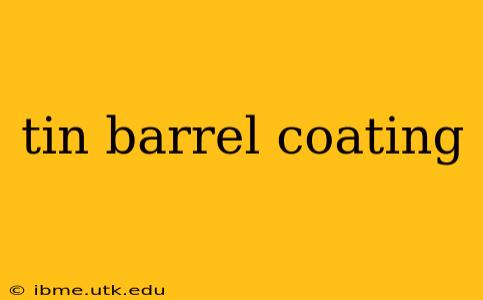Tin barrel coating, also known as tin plating or tinning, is a crucial process in various industries, offering exceptional corrosion resistance and solderability. This comprehensive guide delves into the intricacies of tin barrel coating, exploring its applications, benefits, and the process itself. We'll also address some frequently asked questions surrounding this essential metal finishing technique.
What is Tin Barrel Coating?
Tin barrel coating is an electroplating process where a thin layer of tin is deposited onto metal substrates, typically steel or copper, within a rotating barrel. This method offers a cost-effective and efficient way to protect metal parts from corrosion and enhance their solderability. The process involves immersing the parts in a chemical bath containing tin ions, and using an electric current to deposit the tin onto the surface. The barrel's rotation ensures even coating distribution across all parts.
What are the Benefits of Tin Barrel Coating?
Several key advantages make tin barrel coating a preferred choice across diverse industries:
- Excellent Corrosion Resistance: Tin forms a protective passive layer that shields the underlying metal from environmental elements, preventing rust and degradation. This is particularly crucial for components exposed to harsh conditions.
- Superior Solderability: Tin's excellent solderability makes it ideal for electronic components and applications requiring soldering. The tin coating provides a reliable surface for solder to adhere to, ensuring strong and consistent joints.
- Cost-Effectiveness: Compared to other plating methods, barrel plating offers a cost-effective solution, particularly for high-volume production runs. The automated nature of the process further contributes to efficiency and reduced labor costs.
- Uniform Coating: The rotating barrel ensures a consistent and uniform coating across all parts, regardless of their shape or size. This uniformity is vital for maintaining product quality and performance.
- Environmental Friendliness: Modern tin barrel plating processes utilize environmentally friendly solutions, minimizing the impact on the environment compared to older techniques.
What are the Applications of Tin Barrel Coating?
The versatility of tin barrel coating makes it suitable for a wide range of applications:
- Electronics: It's widely used in the electronics industry to coat connectors, terminals, and other components, enhancing solderability and protecting against corrosion.
- Automotive: Tin plating protects automotive parts from rust and corrosion, extending their lifespan and improving reliability.
- Food and Beverage: In applications where hygiene is paramount, tin coating ensures the safety and integrity of components used in food and beverage processing.
- Hardware: Various hardware components benefit from tin plating, improving their durability and resistance to wear and tear.
What Metals Can Be Tin Barrel Coated?
While steel and copper are the most common substrates, tin barrel coating can be applied to other metals, including:
- Steel: A common choice due to its strength and affordability.
- Copper: Often used in electronics due to its excellent electrical conductivity.
- Brass: Provides good corrosion resistance and aesthetic appeal.
- Aluminum (with pretreatment): Requires specific pretreatment steps to ensure proper adhesion.
How is the Tin Barrel Coating Process Carried Out?
The process typically involves several steps:
- Pre-treatment: The parts undergo cleaning and surface preparation to remove any contaminants or oxides that might hinder proper coating adhesion.
- Plating: The cleaned parts are placed in the rotating barrel, immersed in the tin plating solution, and an electric current is applied to deposit the tin.
- Post-treatment: After plating, the parts are rinsed and dried to remove any residual chemicals.
What are the Different Types of Tin Barrel Coating?
While the basic principle remains the same, variations exist depending on the specific requirements:
- Bright Tin: Produces a shiny, reflective finish.
- Matte Tin: Offers a duller, less reflective surface.
- Specific Tin Alloy Coatings: Alloying tin with other metals can tailor the coating's properties for specific applications.
How Much Does Tin Barrel Coating Cost?
The cost of tin barrel coating varies depending on factors such as:
- Part size and quantity: Larger quantities generally lead to lower per-unit costs.
- Surface area: Larger surface areas require more plating material.
- Specific requirements: Specialized coatings or additional treatments can increase the cost.
What are the Safety Precautions for Tin Barrel Coating?
Proper safety measures are crucial throughout the process to protect both personnel and the environment. This involves using appropriate personal protective equipment (PPE), proper ventilation, and adherence to all relevant safety regulations.
This guide provides a comprehensive overview of tin barrel coating. While it covers many aspects, consulting with a specialist in metal finishing is recommended for specific applications and detailed requirements. Remember that the specifics of the process can vary depending on the manufacturer and the particular needs of the project.
